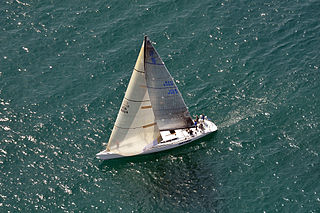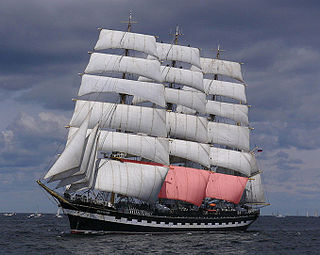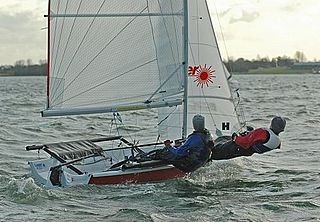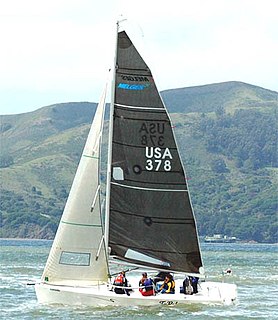
Sailing employs the wind—acting on sails, wingsails or kites—to propel a craft on the surface of the water, on ice (iceboat) or on land over a chosen course, which is often part of a larger plan of navigation.

A sailboat or sailing boat is a boat propelled partly or entirely by sails and is smaller than a sailing ship. Distinctions in what constitutes a sailing boat and ship vary by region and maritime culture.

Dinghy sailing is the activity of sailing small boats by using five essential controls:

A genoa sail is a type of large jib or staysail that extends past the mast and so overlaps the main sail when viewed from the side, sometimes eliminating it. It was originally called an "overlapping jib" and later a genoa jib. It is used on single-masted sloops and twin-masted boats such as yawls and ketches. Its larger surface area increases the speed of the craft in light to moderate winds; in high wind, a smaller jib is usually substituted, and downwind a spinnaker may be used.

A spinnaker is a sail designed specifically for sailing off the wind from a reaching course to a downwind, i.e. with the wind 90–180° off bow. The spinnaker fills with wind and balloons out in front of the boat when it is deployed, called flying. It is constructed of lightweight fabric, usually nylon, and is often brightly coloured. It may be optimised for a particular range of wind angles, as either a reaching or a running spinnaker, by the shaping of the panels and seams.

A mainsail is a sail rigged on the main mast of a sailing vessel.

A Bermuda rig, Bermudian rig, or Marconi rig is a configuration of mast and rigging for a type of sailboat and is the typical configuration for most modern sailboats. This configuration was developed in Bermuda in the 17th century; the term Marconi, a reference to the inventor of the radio, Guglielmo Marconi, became associated with this configuration in the early 20th century because the wires that stabilize the mast of a Bermuda rig reminded observers of the wires on early radio masts.

The Hobie Cat is a small sailing catamaran manufactured by the Hobie Cat Company. Hobie's line of products includes surfboards, sailboats, kayaks, stand-up paddle boards, and pedalboards, although the Hobie Cat Company is known worldwide for its catamarans. Hobie also designed a successful monohull, the Hobie 33.

The Laser 4000 is a racing dinghy designed by Phil Morrison crewed by two persons. Its one-design weight-equalised system enables physically differing sailors to compete on a level playing field. It is most popular in Europe, particularly the UK, France and Italy.

The 18 ft Skiff is considered the fastest class of sailing skiffs. The class has a long history beginning with races on Sydney Harbour, Australia in 1892 and later in New Zealand. The boat has changed significantly since the early days, bringing in new technology as it became available. Because of the need of strength, agility and skill, the class is considered to be the top level of small boat sailing. In Australia this boat is called the "Aussie 18" due to its inherent connections to Australia. It is the fastest conventional non-foiling monohull on the yardstick rating, with a score of 675, coming only third after the Tornado and Inter 20.

A fractional rig on a sailing vessel consists of a foresail, such as a jib or genoa sail, that does not reach all the way to the top of the mast.

The Olson 30 is a sailboat designed by George Olson of Santa Cruz, CA around 1978. Olson was a surfer and surfboard shaper who decided to design a 30' ultra light displacement boat while on a delivery from Honolulu to Santa Cruz on Merlin, a 68' Bill Lee designed and built ultralight sailboat which had competed in the biennial Transpac race in 1977. During this delivery, Olson came up with the idea while sailing with Denis Bassano and Don Snyder, who lent their initials to the prototype's name, SOB 30. The resulting boat was christened Pacific High, and it was launched in 1978.

The 3000 is a racing sailing dinghy crewed by two persons with a trapeze for the crew. Launched in 1996 as the Laser 3000, the 3000 was developed from the Laser 2, using the original Frank Bethwaite-designed planing hull combined with a new designed self-draining deck by Derek Clark. Clark also re-designed the rig, using spars and sails from premium proprietary sources and replacing the symmetric spinnaker of the Laser 2 by a larger asymmetric spinnaker (gennaker). The gennaker is chute-launched and retrieved using a single halyard line, and is set on a retractable bowsprit. Helm balance and handling were improved using a shorter-footed mainsail with two full-width battens giving a larger roach. A mast with conventional spreaders replaced the now-unusual diamond arrangement of the Laser 2.

The Bermuda Fitted Dinghy is a type of racing-dedicated sail boat used for competitions between the yacht clubs of Bermuda. Although the class has only existed for about 130 years, the boats are a continuance of a tradition of boat and ship design in Bermuda that stretches back to the earliest decades of the 17th century.

A sailing yacht, is a leisure craft that uses sails as its primary means of propulsion. A yacht may be a sail or power vessel used for pleasure, cruising, or racing. There is no standard definition, so the term applies here to sailing vessels that have a cabin with amenities that accommodate overnight use. To be termed a "yacht", as opposed to a "boat", such a vessel is likely to be at least 33 feet (10 m) in length and have been judged to have good aesthetic qualities. Sailboats that do not accommodate overnight use or are smaller than 30 feet (9.1 m) are not universally called yachts. Sailing yachts in excess of 130 feet (40 m) are generally considered to be superyachts.

A trailer sailer is a type of sailboat that has been designed to be easily transported using a road trailer towed by an automobile. They are generally larger than a sailing dinghy. Trailer sailers include day sailers and small cabin cruisers, suitable for living on.

The term sportsboat first appeared in the late 1980s and early 1990s to describe trailer sailers that were optimised for high performance at the expense of accommodation and ballast. The very definition of the term "sportsboat" is evolving.

The Esse 850 is an 8.5 metre long racing sportboat designed by Umberto Felci and built by Josef Schuchter Sportboats of Stafa, Switzerland. The first hull was sold in 2004 and the Esse 850 International Class Association was begun in 2005 in Europe.

The Esse 990 is a 9.9 meter long racing sportboat designed by Umberto Felci and built by Josef Schuchter Sportboats of Stafa, Switzerland. The first hull was sold in 2008 and series production was begun in 2009.
The following outline is provided as an overview of and topical guide to sailing: